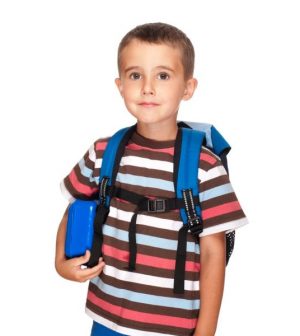- Navigating Your Midlife Crisis: Embracing New Possibilities
- City Raccoons Showing Signs of Domestication
- Mapping the Exposome: Science Broadens Focus to Environmental Disease Triggers
- One Week Less on Social Media Linked to Better Mental Health
- Your Brain Changes in Stages as You Age, Study Finds
- Some Suicide Victims Show No Typical Warning Signs, Study Finds
- ByHeart Formula Faces Lawsuits After Babies Sickened With Botulism
- Switch to Vegan Diet Could Cut Your Greenhouse Gas Emissions in Half
- Regular Bedtime Does Wonders for Blood Pressure
- Dining Alone Could Mean Worse Nutrition for Seniors
Take the Back Pain Out of Backpacks

Backpacks can mean backaches for schoolchildren, but an orthopedic surgeon has advice for parents and kids about how to keep soreness at bay.
“Parents should inspect their child’s backpack from time to time,” said Dr. Joshua Hyman of New York-Presbyterian Morgan Stanley Children’s Hospital in New York City.
Kids “often carry much more than they should, with extra shoes, toys, electronic devices and other unnecessary items,” he explained in a hospital news release.
Hyman suggests that before sending kids off to school, parents should follow these backpack safety tips:
- Be a weight-watcher. According to Hyman, backpacks shouldn’t weigh more than 15 percent of a kid’s body weight. That’s the equivalent of 7 pounds for a 50-pound child.
- Lighten the load. If you feel that your child is weighed down by too many textbooks, talk to the teacher about whether any can be left at school. If not, a backpack on wheels may be an option.
- Two straps are better than one. Encourage your child to wear the straps over both shoulders — not over one shoulder — so the weight of the bag is distributed evenly.
- Size matters. Get a correctly sized backpack that’s not wider or longer than your child’s torso, and make sure it doesn’t hang more than 4 inches below your kid’s waist. A low-hanging backpack could force your child to lean forward while walking.
- The more padding the better. Look for a backpack with straps that are wide and padded to prevent them from digging into the child’s shoulders. Also, look for one with a padded back. This can reduce the risk that your child will be hurt by sharp objects inside the backpack.
- Watch for signs of trouble. Be on the lookout for pain, posture changes, tingling or red marks due to backpack use. If your child’s pain is persistent, talk to your pediatrician.
More information
The American Academy of Pediatrics has more about backpack safety.
Source: HealthDay
Copyright © 2025 HealthDay. All rights reserved.










